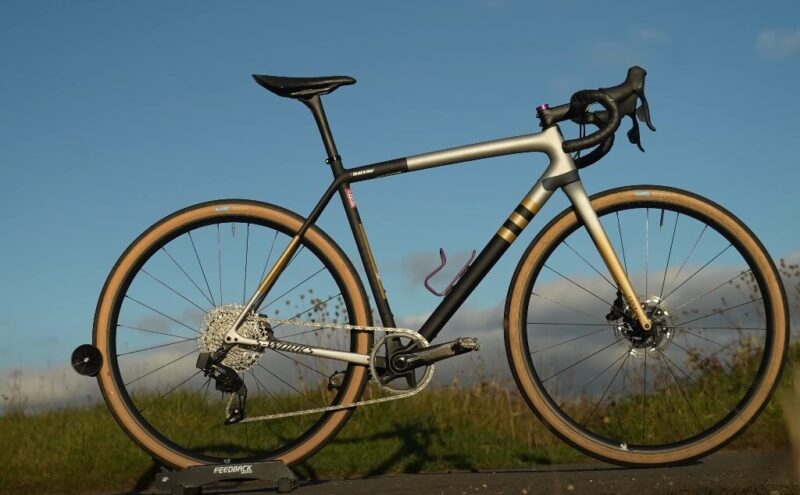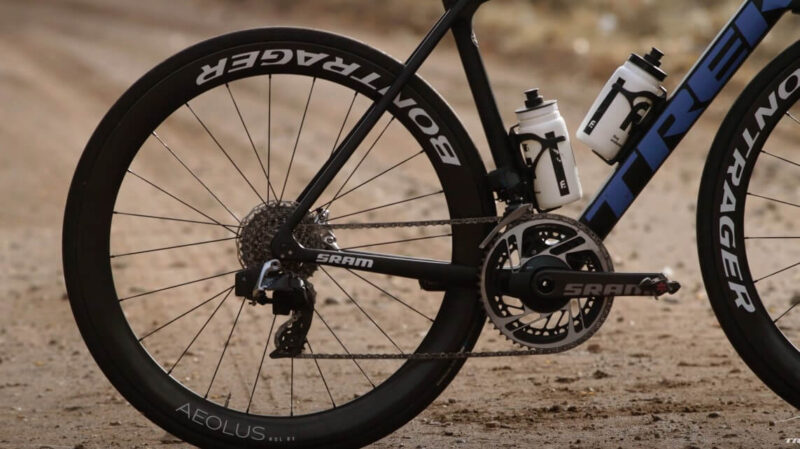As a bike enthusiast, I’ve often found myself torn between the allure of road bikes and the rugged charm of gravel bikes. Each type of bike has its own set of features created for specific riding conditions.
Let’s break down the key differences between gravel bikes and road bikes and help you decide which one suits your cycling style best.
Table of Contents
ToggleA Quick Look
| Feature | Road Bike | Gravel Bike |
| Geometry | Aggressive, aerodynamic | Relaxed, upright |
| Tire Width | 23mm to 28mm | 35mm to 45mm |
| Tread Pattern | Slick or minimal | Knobby or semi-slick |
| Drivetrain | Typically 2x | 1x or 2x |
| Suspension | Generally none | May include front suspension or suspension posts |
| Brakes | Rim or disc brakes | Disc brakes |
| Handlebars | Narrow drop handlebars | Wider, flared drop handlebars |
| Primary Use | Speed on paved surfaces | Versatility on mixed terrains |
| Weight | 6-9 kg (high-end models) | 8-12 kg |
| Price Range | Broad range, high-end can be very expensive | Broad range, high-end can be expensive |
1. Geometry and Frame Design

Road Bike
Road bikes are designed with speed and efficiency in mind. They feature a lower and longer frame that puts the rider in a more aerodynamic position.
This aggressive geometry reduces wind resistance, making it easier to maintain high speeds over long distances. Typically, road bike frames are lighter and stiffer, which aids in better power transfer and quick acceleration.
Gravel Bike
Gravel bikes prioritize comfort and stability, especially over rough terrains. They have a more relaxed geometry, featuring a taller headtube and a shorter top tube.
This setup allows for a more upright riding position, reducing strain on the rider’s back and neck during extended rides.
The longer wheelbase, slacker head angle, and robust spokes enhance stability and handling on loose and uneven surfaces.
2. Tires and Wheels

Road Bike
Road bikes come with narrower tires, generally ranging from 23mm to 28mm in width.
These tires minimize rolling resistance on smooth pavements, thanks to their slick or minimal tread pattern that maximizes contact with the road. This design improves grip and speed on paved surfaces.
Gravel Bike
Gravel bikes, in contrast, use wider tires, typically between 35mm to 45mm. The increased width provides better traction and stability on gravel, dirt, and mud.
These tires often feature a knobby or semi-slick tread pattern, offering superior grip on varied terrains while maintaining efficiency on paved roads.
3. Drivetrain and Gearing

Road Bike
Most road bikes feature a 2x drivetrain, with two front chainrings and a range of gears at the back. This setup allows for smooth and efficient gear transitions, ideal for maintaining high speeds and tackling steep climbs on paved roads.
The closer gear ratios help fine-tune cadence and speed, making road bikes highly efficient on tarmac.
Gravel Bike
Gravel bikes can be equipped with either a 1x or 2x drivetrain. The 1x setup, featuring a single front chainring, simplifies shifting and reduces mechanical issues on rough terrain.
Meanwhile, the 2x setup offers a wider range of gears, making it versatile for both flat and hilly terrains. Gravel bike gearing is generally lower to handle steep and rough climbs more effectively.
4. Suspension and Comfort Features
Road Bike
Road bikes focus on minimizing weight and maximizing efficiency. As such, they usually lack suspension features. Comfort is primarily managed through frame design and tire pressure.
Some high-end road bikes might incorporate small compliance features in the frame or seat post to absorb minor vibrations, but overall, the emphasis is on speed rather than comfort.
Gravel Bike
Gravel bikes often come with additional comfort features to handle rough terrains. These can include front suspension forks, suspension seat posts, or even frame designs that allow for more flex and shock absorption.
These features reduce fatigue and improve ride comfort over long distances on uneven surfaces.
5. Braking Systems

Road Bike
Traditionally, road bikes used rim brakes, but disc brakes have become increasingly popular. Disc brakes offer superior stopping power and modulation, especially in wet or variable conditions.
They also provide consistent performance over long descents, making them a preferred choice for modern road bikes.
Gravel Bike
Gravel bikes almost exclusively use disc brakes due to their reliability and performance in various conditions.
Disc brakes are less affected by mud and debris, common in gravel riding. They provide better control and stopping power on loose surfaces, enhancing safety and confidence on technical terrains. Also, helmet is a must, regardless of the bike you choose.
6. Handlebars and Control
Road Bike
Road bikes use drop handlebars, which allow for multiple hand positions and an aerodynamic riding stance. The lower position helps reduce wind resistance, making it ideal for high-speed riding.
The narrow width of the bars also aids in quick and precise handling, which is crucial in competitive road cycling.
Gravel Bike
Gravel bikes also feature drop handlebars, but they are typically wider and have a flared design. This provides better control and stability on rough terrain.
The wider bars offer more leverage, making it easier to handle technical sections and steep descents. Some gravel handlebars also include additional grip positions for long-distance comfort.
7. Versatility and Use Cases

Road Bike
Road bikes are designed for performance on paved surfaces, making them ideal for road racing, group rides, and long-distance touring on smooth roads.
They are less suited for off-road use and can struggle on gravel or dirt paths due to their narrow tires and aggressive geometry.
Gravel Bike
Gravel bikes are highly versatile and can handle a variety of surfaces, from smooth pavements to rugged trails.
They are perfect for adventure riding, bikepacking, and exploring less-traveled routes. The ability to fit wider tires and additional gear makes them suitable for long-distance touring and multi-day expeditions.
8. Weight and Material
Road Bike
Road bikes prioritize lightweight construction for better speed and efficiency. High-end road bikes often use carbon fiber frames and components, reducing the overall weight to as low as 6-7 kg.
Even entry-level road bikes are designed to be as light as possible within budget constraints.
Gravel Bike
Gravel bikes tend to be slightly heavier than road bikes due to their more robust construction. They need to withstand rougher conditions and carry additional gear.
While many gravel bikes also use carbon fiber, they may incorporate more durable materials and designs, resulting in weights typically around 8-12 kg.
9. Price and Accessibility
Road Bike
The cost of road bikes can vary widely based on materials and components. High-end models can be very expensive, often costing several thousand dollars.
However, there are also more affordable entry-level options that offer good performance for beginners and casual riders.
Gravel Bike
Gravel bikes also span a broad price range. High-end models can be quite costly due to advanced materials and features, but there are budget-friendly options available.
The price often reflects the bike’s versatility and durability, making them a worthwhile investment for riders seeking adventure and varied terrain.
Final Thoughts
The key differences between gravel bikes and road bikes lie in their design and intended use. Road bikes are built for speed and efficiency on paved roads, featuring aggressive geometry, narrow tires, and lightweight construction.
Gravel bikes, meanwhile, prioritize comfort and stability on mixed terrains, with wider tires, relaxed geometry, and additional comfort features. Knowing these differences can help riders choose the right bike based on their riding preferences and the type of terrain they plan to tackle.
So, whether you’re a speed enthusiast looking to conquer paved roads or an adventure seeker ready to explore uncharted paths, there’s a bike out there tailored just for you.
Related Posts:
- Trek vs. Specialized Bikes – 8 Key Differences Explained
- Cyclocross vs. Gravel Bike - 7 Key Differences You…
- Key Differences Between 4-Stroke and 2-Stroke…
- Bike Brakes Explained: Disc Brakes vs Rim Brakes vs V-Brakes
- Should Bicycle Tires Be Inflated to Maximum PSI (Explained)
- Why You Need a Quality Road Bike Helmet - Protect…








